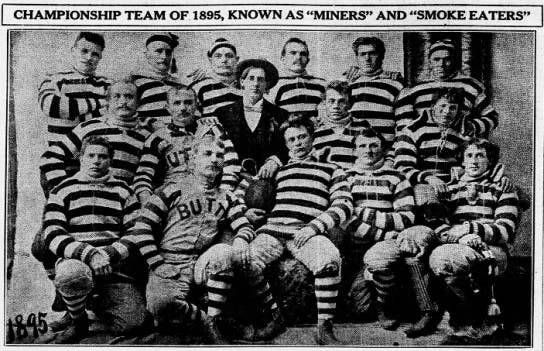Today's Tidbit... Fourth Of July Football In 1895 Butte
From football's beginning in America's Eastern colleges, the game was played almost exclusively in the fall. Only on the West Coast and in the Rockies did 19th-century teams play football at other times of the year, with some playing football year-round.
One team that played year-round at times was the Butte Football Club Miners, who primarily played West Coast club teams and college and club teams from west of the Mississippi. One of their games, a contest against the Omaha YMCA team, was part of Butte's Fourth of July Celebration in 1895.
Butte was a mining town of 25,000 inhabitants in 1895; the number was reduced by 57 after two warehouses storing dynamite exploded in January. A rough-and-tumble town filled with immigrant miners, some appreciated American football as players and fans, so the newly-formed Butte Miners scheduled a football game as part of the city’s broader celebration on the 4th.
The Miners played their first game in April 1895, beating the Spokane Athletic Club 18-0, and followed that by beating the Salt Lake City YMCA 52-0 at the end of May.
Next up was the Fourth of July game with Omaha. Omaha's team was led by C. L. Thomas, a Michigan alum, and Willie Gardner, known for his Sampson-like locks. Omaha visited Butte for a Thanksgiving Day game in 1894, leaving town with a 48-4 victory over a less organized group of Butte footballers. Since then, the Miners had built a new field at the race track with seating for 2,000 and plenty of space for carriages to line the rest of the field’s perimeter. Unfortunately for visiting teams, most did not know until their arrival that grass did not grow on the field due to the smoke and other residues from the nearby copper smelters.
Special trains on the Butte, Anaconda, and Pacific Railroad allowed those from nearby towns to arrive in Butte in time for the football game. Most remained for the bicycle races, baseball, greased pig chases, and similar festivities. Of course, everyone hoped the celebration would not end in a riot like the previous year when several men were killed.
Before the game, the Butte and Omaha teams were paraded to the grounds behind a decorated hook-and-ladder engine in time for the 2:30 start. The 3,000 to 4,000 attendees filled the stands while the society ladies and their hosts watched from their carriages. Presumably, they saw a good game, though newspaper reports of the game and its stars are scant. We know Butte pulled off the upset, outscoring Omaha by 6-0, which was quite a turnaround from the 1894 game. Better yet, the day passed without rioting or deaths, though at least one miner blew off his hand, lighting fireworks.
With the victory over Omaha, Butte challenged all comers to games and finished the year with a 12-3 record. One of their victories came over Iowa State in a mid-September game. The Iowa State team included player-coach Pop Warner, who lost a sizable bet as a result of their 12-10 loss to Butte. Warner was fortunate to be paid to coach both Iowa State and Auburn that year to make up for his gambling losses.

Football Archaeology is reader-supported. Click here to buy one of my books or otherwise support the site.


